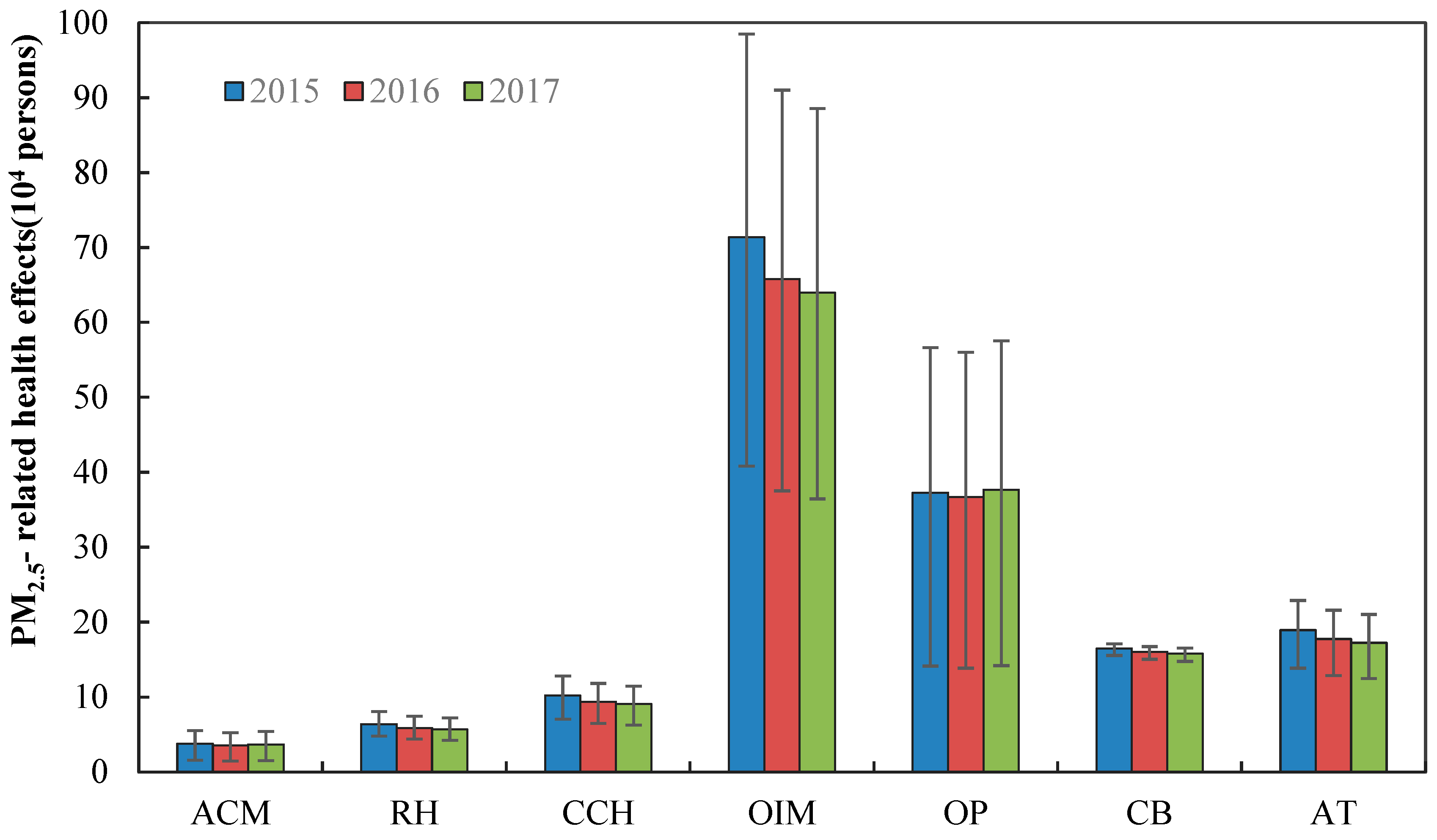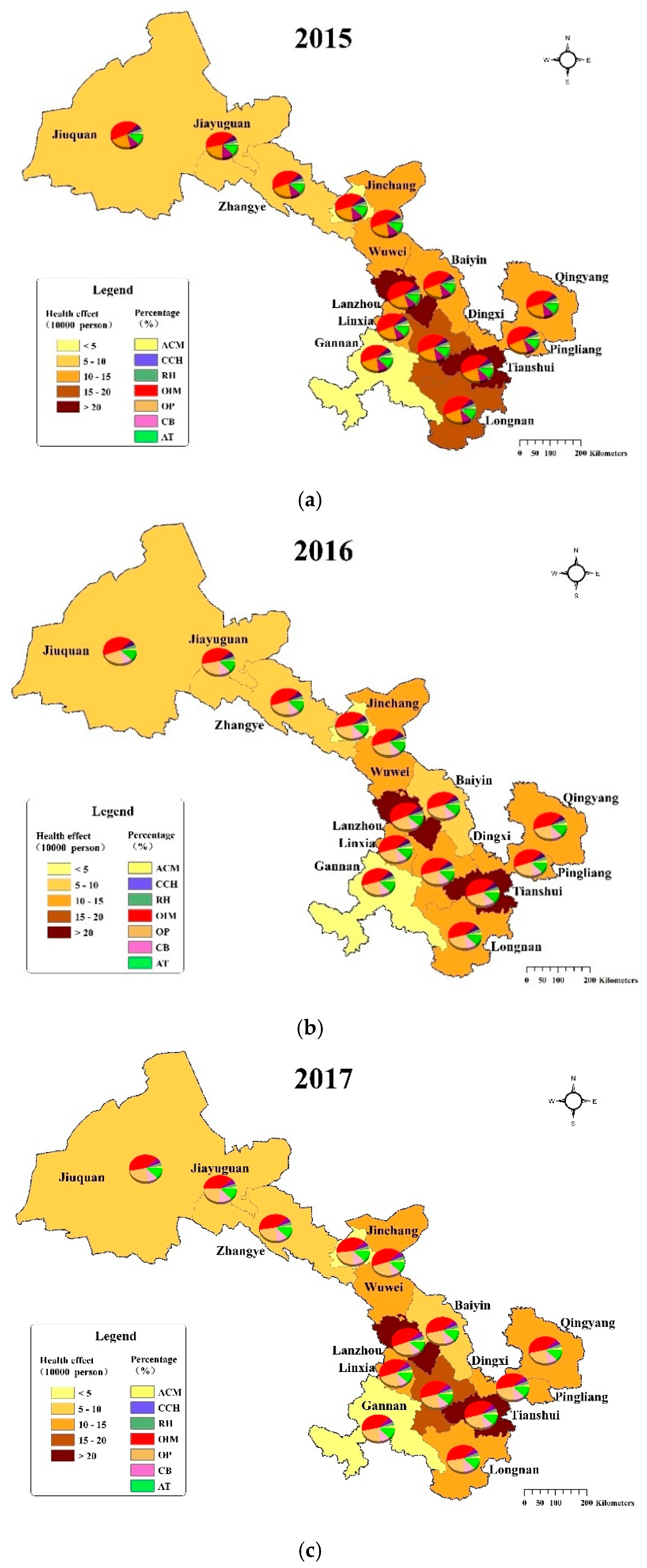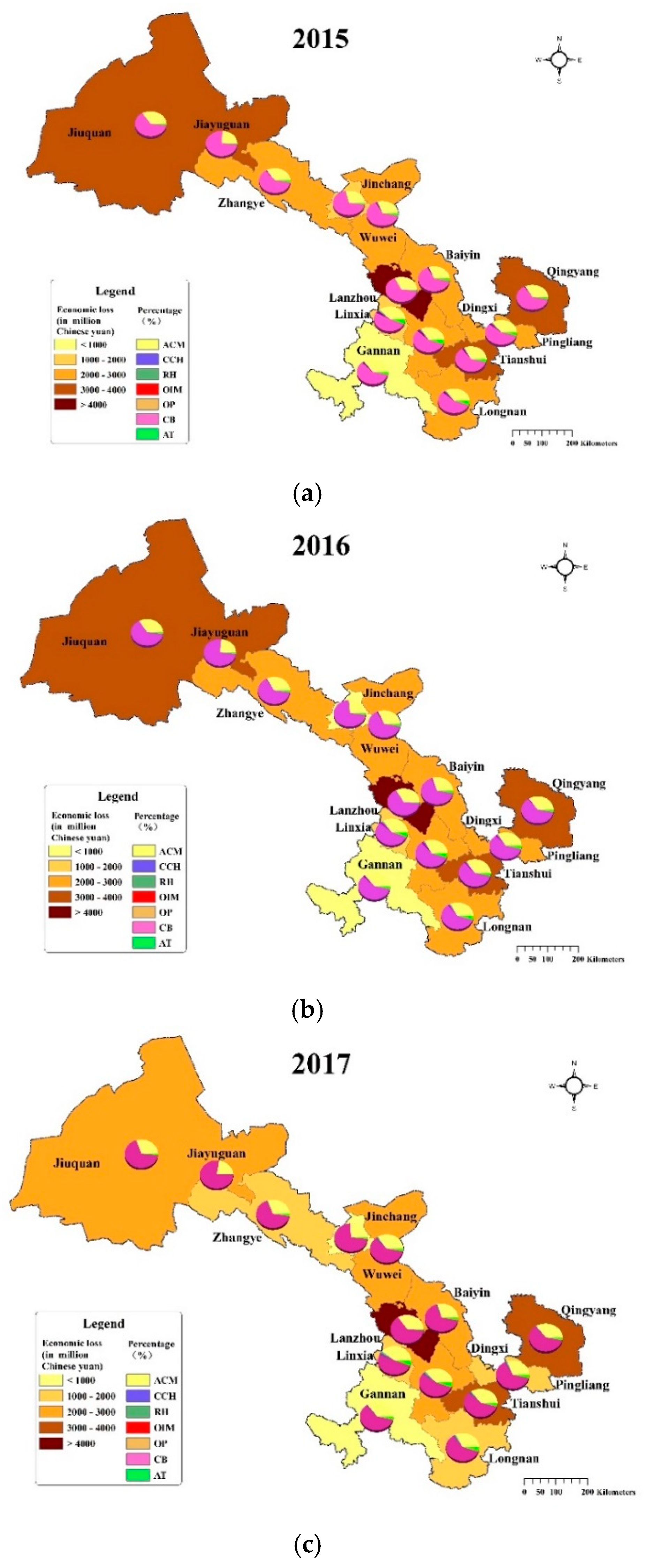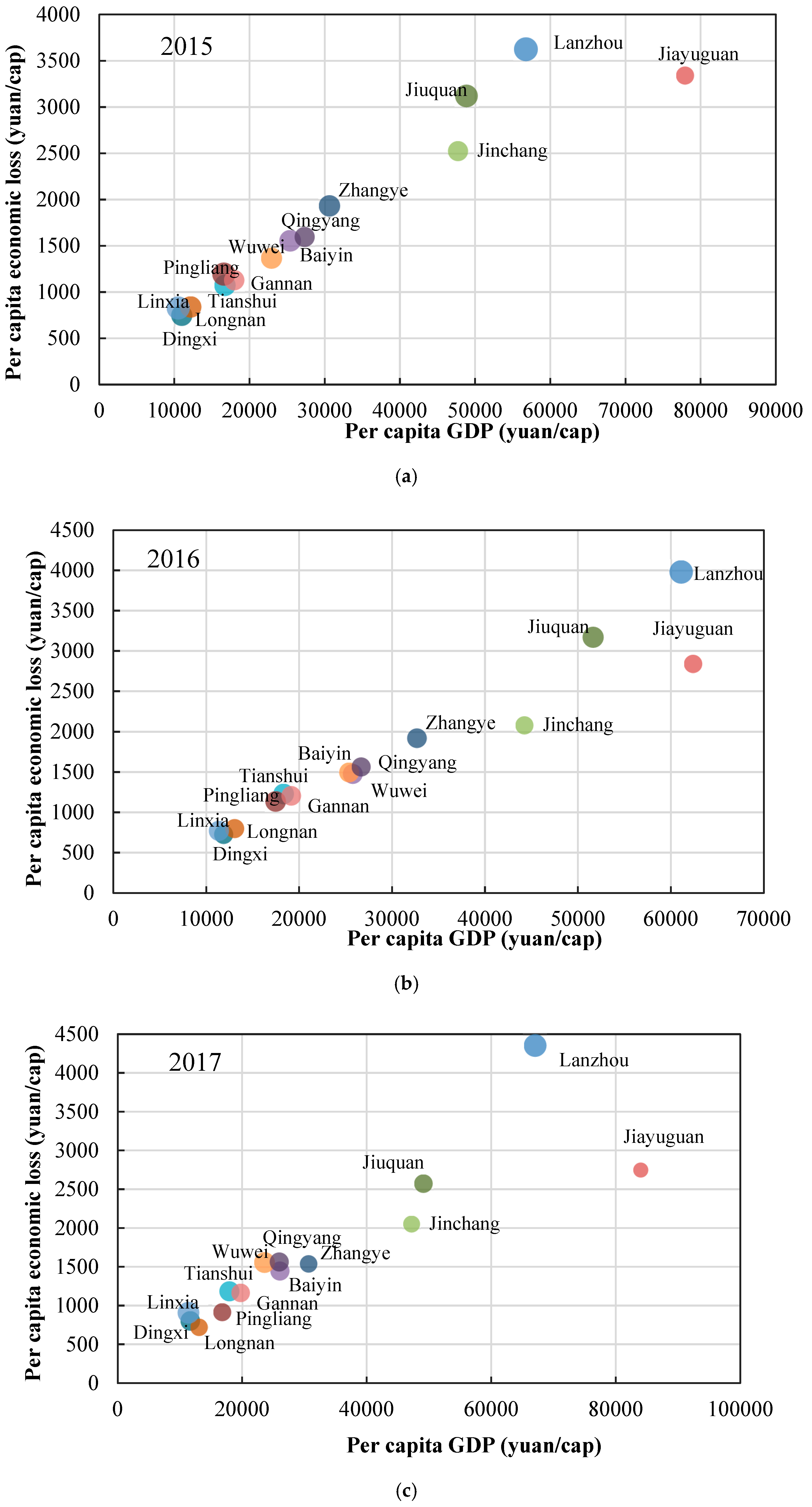Health and Economic Loss Assessment of PM2.5 Pollution during 2015–2017 in Gansu Province, China
Abstract
:1. Introduction
2. Materials and Methods
2.1. Study Areas
2.2. Data Collection
2.2.1. PM2.5 Concentrations and Socio-Economic Data
2.2.2. Exposure–Response Coefficients
2.2.3. Health Information
2.3. Estimating Health Effects
2.4. Economic Loss Evaluation of Health Effects
2.4.1. Amended Human Capital (AHC)
2.4.2. Cost of Illness (COI)
3. Results
3.1. PM2.5 Pollution Characteristics
3.2. Health Effects of PM2.5 Pollution
3.3. Economic Loss of PM2.5 Pollution
4. Discussions
4.1. Correlation Analysis with Social Economic Development
4.2. Policy Implications
4.3. Uncertainty Analysis
5. Conclusions
Author Contributions
Funding
Conflicts of Interest
References
- The World Bank. The Cost of Air Pollution: Strengthening the Economic Case for Action; The World Bank: Washington, DC, USA, 2016. [Google Scholar]
- WHO. Ambient Air Pollution: A Global Assessment of Exposure and Burden of Disease; World Health Organization: Geneva, Switzerland, 2016. [Google Scholar]
- Forouzanfar, M.H.; Afshin, A.; Alexander, L.T.; Anderson, H.R.; Bhutta, Z.A.; Biryukov, S.; Brauer, M.; Burnett, R.; Cercy, K.; Charlson, F.J.; et al. Global, regional, and national comparative risk assessment of 79 behavioural, environmental and occupational, and metabolic risks or clusters of risks, 1990–2015: A systematic analysis for the Global Burden of Disease Study 2015. Lancet 2016, 388, 1659–1724. [Google Scholar] [CrossRef] [Green Version]
- Silver, B.; Reddington, C.L.; Arnold, S.R.; Spracklen, D.V. Substantial changes in air pollution across China during 2015–2017. Environ. Res. Lett. 2018, 13, 114012. [Google Scholar] [CrossRef]
- Wu, P.; Ding, Y.H.; Liu, Y.J. Atmospheric circulation and dynamic mechanism for persistent haze events in the Beijing-Tianjin-Hebei region. Adv. Atmos. Sci. 2017, 34, 429–440. [Google Scholar] [CrossRef] [Green Version]
- Xie, Z.X.; Li, Y.; Qin, Y.C.; Rong, P.J. Value Assessment of Health Losses Caused by PM2.5 Pollution in Cities of Atmospheric Pollution Transmission Channel in the Beijing-Tianjin-Hebei Region, China. Int. J. Environ. Res. Public Health 2019, 16, 1012. [Google Scholar] [CrossRef] [PubMed] [Green Version]
- Lin, H.L.; Liu, T.; Xiao, J.P.; Zeng, W.L.; Li, X.; Guo, L.C.; Zhang, Y.H.; Xu, Y.J.; Tao, J.; Xian, H.; et al. Mortality burden of ambient fine particulate air pollution in six Chinese cities: Results from the Pearl River Delta study. Environ. Int. 2016, 96, 91–97. [Google Scholar] [CrossRef] [PubMed]
- Dehghani, M.; Fazlzadeh, M.; Sorooshian, A.; Tabatabaee, H.R.; Miri, M.; Baghani, A.N.; Delikhoon, M.; Mahvi, A.H.; Rashidi, M. Characteristics and health effects of BTEX in a hot spot for urban pollution. Ecotoxicol. Environ. Saf. 2018, 155, 133–143. [Google Scholar] [CrossRef]
- Burnett, R.; Chen, H.; Szyszkowicz, M.; Fann, N.; Hubbell, B.; Pope, C.A.; Apte, J.S.; Brauer, M.; Cohen, A.; Weichenthal, S.; et al. Global estimates of mortality associated with long-term exposure to outdoor fine particulate matter. Proc. Natl. Acad. Sci. USA 2018, 115, 9592–9597. [Google Scholar] [CrossRef] [Green Version]
- Yang, B.Y.; Qian, Z.M.; Li, S.S.; Fan, S.J.; Chen, G.B.; Syberg, K.M.; Xian, H.; Wang, S.Q.; Ma, H.M.; Chen, D.H.; et al. Long-term exposure to ambient air pollution (including PM1) and metabolic syndrome: The 33 Communities Chinese Health Study (33CCHS). Environ. Res. 2018, 164, 204–211. [Google Scholar] [CrossRef]
- Karimi, A.; Shirmardi, M.; Mostafa, H.; Birgani, Y.T.; Neisi, A.; Takdastan, A.; Goudarzi, G. Concentrations and health effects of short- and long-term exposure to PM2.5, NO2, and O3 in ambient air of Ahvaz city, Iran (2014–2017). Ecotoxicol. Environ. Saf. 2019, 180, 542–548. [Google Scholar] [CrossRef]
- Filonchyk, M.; Yan, H.W.; Li, X.J. Temporal and spatial variation of particulate matter and its correlation with other criteria of air pollutants in Lanzhou, China, in spring-summer periods. Atmos. Pollut. Res. 2018, 9, 1100–1110. [Google Scholar] [CrossRef]
- Lv, L.Y.; Li, H.Y. Health Economic Evaluation of PM10 and PM2.5 Pollution in Beijing-Tianjin-Hebei Region of China. Acta Scientiarum Naturalium Universitatis Nankaiensis 2016, 49, 69–77. [Google Scholar]
- Bayat, R.; Ashrafi, K.; Motlagh, M.S.; Hassanvand, M.S.; Daroudi, R.; Fink, G.; Künzli, N. Health impact and related cost of ambient air pollution in Tehran. Environ. Res. 2019, 176, 108547. [Google Scholar] [CrossRef] [PubMed]
- Landrigan, P.J.; Fuller, R.; Acosta, N.J.R.; Adeyi, O.; Arnold, R.; Basu, N.; Baldé, A.B.; Bertollini, R.; Reilly, S.B.; Boufford, J.I.; et al. The Lancet Commission on pollution and health. Lancet 2018, 391, 462–512. [Google Scholar] [CrossRef] [Green Version]
- OECD. The Cost of Air Pollution: Health Impacts of Road Transport; OECD: Paris, France, 2014. [Google Scholar]
- RAND. Costs of Selected Policies to Address Air Pollution in China; RAND Corporation: Santa Monica, CA, USA, 2015. [Google Scholar]
- WHO Regional Office for Europe. Economic Cost of the Health Impact of Air Pollution in Europe: Clean Air, Health and Wealth; WHO Regional Office for Europe: Copenhagen, Denmark, 2015. [Google Scholar]
- Apte, J.S.; Marshall, J.D.; Cohen, A.J.; Brauer, M. Addressing global mortality from ambient PM2.5. Environ. Sci. Technol. 2015, 49, 8057–8066. [Google Scholar] [CrossRef]
- Pope, C.A.; Burnett, R.T.; Thun, M.J.; Calle, E.E.; Krewski, D.; Ito, K.; Thurston, G.D. Lung cancer, cardiopulmonary mortality, and long-term exposure to fine particulate air pollution. J. Am. Med. Assoc. 2002, 287, 1132–1141. [Google Scholar] [CrossRef] [Green Version]
- Kan, H.D.; Chen, B.H. Analysis of Exposure-Response Relationships of Air Particulate Matter and Adverse Health Outcomes in China. J. Environ. Health 2002, 19, 422–424. [Google Scholar]
- Lelieveld, J.; Evans, J.S.; Fnais, M.; Giannadaki, D.; Pozzer, A. The contribution of outdoor air pollution sources to premature mortality on a global scale. Nature 2015, 525, 367–371. [Google Scholar] [CrossRef]
- Zhang, M.S.; Song, Y.; Cai, X.H. A health-based assessment of particulate air pollution in urban areas of Beijing in 2000–2004. Sci. Total Environ. 2007, 376, 100–108. [Google Scholar] [CrossRef]
- Hou, Q.; An, X.; Wang, Y.; Tao, Y.; Sun, Z. An assessment of China’s PM10-related health economic losses in 2009. Sci. Total Environ. 2012, 435, 61–65. [Google Scholar] [CrossRef]
- Zhao, X.L.; Yu, X.Y.; Wang, Y.; Fan, C.Y. Economic evaluation of health losses from air pollution in Beijing, China. Environ. Sci. Pollut. Res. 2016, 23, 11716–11728. [Google Scholar] [CrossRef]
- Yin, H.; Pizzol, M.; Jacobsen, J.B.; Xu, L.Y. Contingent valuation of health and mood impacts of PM2.5 in Beijing, China. Sci. Total Environ. 2018, 630, 1269–1282. [Google Scholar] [CrossRef] [PubMed]
- Wu, R.; Dai, H.C.; Geng, Y.; Xie, Y.; Masui, T.; Liu, Z.Q.; Qian, Y.Y. Economic Impacts from PM2.5 Pollution-Related Health Effects: A Case Study in Shanghai. Environ. Sci. Technol. 2017, 51, 5035–5042. [Google Scholar] [CrossRef] [PubMed]
- Yu, G.H.; Wang, F.F.; Hu, J.; Liao, Y.; Liu, X.Z. Value Assessment of Health Losses Caused by PM2.5 in Changsha City, China. Int. J. Environ. Res. Public Health 2019, 16, 2063. [Google Scholar] [CrossRef] [PubMed] [Green Version]
- Xie, Y.; Dai, H.C.; Hanaoka, T.; Masui, T. Health and economic impacts of PM2.5 pollution in Beijing-Tianjin-Hebei Area. China Popul. Resour. Environ. 2016, 26, 19–27. [Google Scholar]
- Huang, D.S.; Xu, J.H.; Zhang, S.Q. Valuing the health risks of particulate air pollution in the Pearl River Delta, China. Environ. Sci. Policy 2012, 15, 38–47. [Google Scholar] [CrossRef]
- Lu, X.C.; Yao, T.; Fung, J.C.H.; Lin, C.Q. Estimation of health and economic costs of air pollution over the Pearl River Delta region in China. Sci. Total Environ. 2016, 566, 134–143. [Google Scholar] [CrossRef] [Green Version]
- Maji, K.J.; Ye, W.F.; Arora, M.; Nagendra, S.M.S. PM2.5-related health and economic loss assessment for 338 Chinese cities. Environ. Int. 2018, 121, 392–403. [Google Scholar] [CrossRef]
- Yang, Y.; Luo, L.W.; Song, C.; Yin, H.; Yang, J.T. Spatiotemporal Assessment of PM2.5-Related Economic Losses from Health Impacts during 2014–2016 in China. Int. J. Environ. Res. Public Health 2018, 15, 1278. [Google Scholar] [CrossRef] [PubMed] [Green Version]
- Li, L.; Lei, Y.L.; Wu, S.M.; Chen, J.B.; Yan, D. The health economic loss of fine particulate matter (PM2.5) in Beijing. J. Clean. Prod. 2017, 161, 1153–1161. [Google Scholar] [CrossRef]
- Wang, J.; Wang, S.; Voorhees, A.S.; Zhao, B.; Jang, C.; Jiang, J.K.; Fu, J.S.; Ding, D.; Zhu, Y.; Hao, J.M. Assessment of short-term PM2.5-related mortality due to different emission sources in the Yangtze River Delta, China. Atmos. Environ. 2015, 123, 440–448. [Google Scholar] [CrossRef]
- Qi, Y.; Lu, H.Y. Pollution, health and inequality—Overcoming the trap of “environmental health poverty”. Manag. World 2015, 9, 32–51. [Google Scholar]
- Gansu Province Bureau of Statistics. Gansu Development Yearbook 2018; China Statistics Press: Beijing, China, 2018.
- Wang, S.; Feng, X.; Zeng, X.; Ma, Y.; Shang, K. A study on variations of concentrations of particulate matter with different sizes in Lanzhou, China. Atmos. Environ. 2009, 43, 2823–2828. [Google Scholar] [CrossRef]
- Gansu Province Bureau of Statistics. Gansu Development Yearbook 2016; China Statistics Press: Beijing, China, 2016.
- Gansu Province Bureau of Statistics. Gansu Development Yearbook 2017; China Statistics Press: Beijing, China, 2017.
- Yin, Y.W.; Cheng, J.P.; Duan, Y.S.; Wei, H.P.; Ji, R.X.; Yu, J.L.; Yu, H.R. Economic evaluation of residents’ health hazard caused by PM2.5 of haze pollution in a city. J. Environ. Health 2011, 28, 250–252. [Google Scholar]
- Wang, R.H. The Time Series Analysis of Air Pollution and the Mortality Caused by Respiratory and Circulatory System Disease in Lanzhou City; Lanzhou University: Lanzhou, China, 2017. [Google Scholar]
- Tao, Y.; Liu, Y.M.; Mi, S.Q.; Guo, Y.T. Atmospheric pollution characteristics of fine particles and their effects on human health. Acta Sci. Circumstantiae 2014, 34, 592–597. [Google Scholar]
- Li, H.J.; Zhou, D.Q.; Wei, Y.J. An Assessment of PM2.5-Related Health Risks and Associated Economic Losses in Chinese Cities. Environ. Sci. 2018, 39, 3467–3475. [Google Scholar]
- Xie, P.; Liu, X.Y.; Liu, Z.R.; Li, T.T.; Bai, Y.H. Exposure-response functions for health effects of ambient particulate matter pollution applicable for China. China Environ. Sci. 2009, 29, 1034–1040. [Google Scholar]
- National Health Commission of the People’s Republic of China. China Health and Family Planning Statistical Yearbook 2016; China Union Medical University Press: Beijing, China, 2016. [Google Scholar]
- Center for Health Statistics and Information. An Analysis Report of National Health Service Survey in China (2013); China Union Medical University Press: Beijing, China, 2015.
- National Health Commission of the People’s Republic of China. China Health and Family Planning Statistical Yearbook 2017; China Union Medical University Press: Beijing, China, 2017.
- National Health Commission of the People’s Republic of China. China Health and Family Planning Statistical Yearbook 2018; China Union Medical University Press: Beijing, China, 2018.
- Yang, D.R.; Wang, H.X.; Lan, L.; Tao, Y.; Mi, S.Q. Evaluation of Economic Losses Due to Human Health Damage from Air Pollution before and after Energy Reform in Lanzhou. Environ. Eng. 2013, 31, 112–116. [Google Scholar]
- Wei, G.R.; Shi, X.M. Evaluation the Extent of Health Damage Caused by PM2.5 Particulate in Xi’an City. Environ. Sci. 2018, 39, 3015–3021. [Google Scholar]
- Liu, C.H.; Hong, J.G.; Shang, Y.X.; Sun, J.; Duolikun, M.; Shan, M.N.; Gao, Y.; Ren, X.M.; Liu, C.S.; Zhang, Y.J.; et al. Comparison of asthma prevalence in children from 16 cities of China in 20 years. Chin. J. Pract. Pediatr. 2015, 30, 596–600. [Google Scholar]
- Xie, Z.; Qin, Y.; Zhang, L.; Zhang, R. Death effects assessment of PM2.5 Pollution in China. Pol. J. Environ. Stud. 2018, 27, 1813–1821. [Google Scholar] [CrossRef]
- Yin, H.; Pizzol, M.; Xu, L. External costs of PM2.5 pollution in Beijing, China: Uncertainty analysis of multiple health impacts and costs. Environ. Pollut. 2017, 26, 356–369. [Google Scholar] [CrossRef] [PubMed]
- Han, M.X.; Guo, X.M.; Zhang, Y.S. The human capital loss of air pollution in cities, China. China Environ. Sci. 2006, 26, 509–512. [Google Scholar]
- Ministry of Ecology and Environment of the People’s Republic of China. China Environmental Status Bulletin (2015–2017). Available online: http://www.mee.gov.cn/hjzl/zghjzkgb/lnzghjzkgb/ (accessed on 29 August 2019).
- Yin, H.; Xu, L.Y.; Cai, Y.P. Monetary Valuation of PM10-Related Health Risks in Beijing China—The Necessity for PM10 Pollution Indemnity. Int. J. Environ. Res. Public Health 2015, 12, 9967–9987. [Google Scholar] [CrossRef] [PubMed] [Green Version]
- Han, F.; Lu, X.C.; Xiao, C.C.; Chang, M.; Huang, K. Estimation of Health Effects and Economic Losses from Ambient Air Pollution in Undeveloped Areas: Evidence from Guangxi, China. Int. J. Environ. Res. Public Health 2019, 16, 2707. [Google Scholar] [CrossRef] [PubMed] [Green Version]
- Lin, X.; Wang, D. Spatiotemporal evolution of urban air quality and socioeconomic driving forces in China. J. Geogr. Sci. 2016, 26, 1533–1549. [Google Scholar] [CrossRef]
- Yang, S.Y.; Fang, D.L.; Chen, B. Human health impact and economic effect for PM2.5 exposure in typical cities. Appl. Energy 2019, 249, 316–325. [Google Scholar] [CrossRef]
- The Official Website of Gansu Province, China. Former Choking City Breathes Clean Air in More Days. Available online: http://www.chinadaily.com.cn/m/gansu/2016-02/16/content_23506776.htm (accessed on 5 September 2019).
- Liu, S.; Song, G.J. Evaluation of PM2.5’s adverse human health effect in cities. Acta Sci. Circumstantiae 2016, 36, 1468–1476. (In Chinese) [Google Scholar]
- Lu, J.G.; Lee, J.J.; Gino, F.; Galinsky, A.D. Polluted Morality: Air Pollution Predicts Criminal Activity and Unethical Behavior. Psychol. Sci. 2018, 29, 340–355. [Google Scholar] [CrossRef] [Green Version]
- Zhang, X.; Chen, X.; Zhang, X. The impact of exposure to air pollution on cognitive performance. Proc. Natl. Acad. Sci. USA 2018, 115, 9193–9197. [Google Scholar] [CrossRef] [Green Version]
- Guo, X.B.; Yang, X. Environmental Pollution and Health Research Series (Part. 1): Air Pollution and Health; Hubei Publishers of Science and Technology: Wuhan, China, 2015. [Google Scholar]
- Zhang, D.; Aunan, K.; Seip, H.M.; Larssen, S.; Liu, J.; Zhang, D. The assessment of health damage caused by air pollution and its implication for policy making in Taiyuan, Shanxi, China. Energy Policy 2010, 38, 491–502. [Google Scholar] [CrossRef] [Green Version]







| Health Outcome | Exposure–Response Coefficient β (95%CI) |
|---|---|
| All-cause mortality | 0.0083 (0.0032, 0.0131) [42] |
| Respiratory hospitalization | 0.00604 (0.00441, 0.00789) [43] |
| Cardiovascular and cerebrovascular hospitalization | 0.00697 (0.00464, 0.00906) [43] |
| Outpatient visits to internal medicine | 0.0049 (0.0027, 0.007) [44] |
| Outpatient visits to pediatrics | 0.0056 (0.002, 0.009) [44] |
| Chronic bronchitis (0–14) | 0.0486 (0.0401, 0.0570) [13] |
| Chronic bronchitis (≥15) | 0.0686 (0.0574, 0.0797) [13] |
| Asthma attacks (0–14) | 0.0208 (0.0118, 0.0300) [45] |
| Asthma attacks (≥15) | 0.021 (0.0145, 0.0274) [45] |
| Year | 2015 | 2016 | 2017 | |
|---|---|---|---|---|
| Mortality (‰) | Mortality Rate per City [37,39,40] | |||
| Morbidity (‰) | Chronic bronchitis (0–14) | 7.2 [46] | 7.2 | 7.2 |
| Chronic bronchitis (≥15) | 7.2 | 7.2 | 7.2 | |
| Asthma attacks (0–14) | 23.9 [52] | 23.9 | 23.9 | |
| Asthma attacks (≥15) | 12.4 [51] | 12.4 | 12.4 | |
| Visiting Rate (‰) | Outpatient visits to internal medicine | 179.8 [46] | 180.6 [48] | 181.3 [49] |
| Outpatient visits to pediatrics | 83.1 [46] | 89.1 [48] | 94.4 [49] | |
| Hospitalization Rate (‰) | Respiratory hospitalization | 13.3 [47] | 13.3 | 13.3 |
| Cardio-cerebrovascular hospitalization | 18.7 [47] | 18.7 | 18.7 | |
| Medical Costs Per Case (CNY/case) | outpatient costs | 169.7 [46] | 177.4 [48] | 190.9 [49] |
| hospitalization costs | 5447.1 [46] | 5587.5 [48] | 5769.8 [49] | |
| Loss of Working Time (day) | average outpatient time | 0.5 | 0.5 | 0.5 |
| average hospitalization time | 9.7 [46] | 9.1 [48] | 8.8 [49] | |
| Health Outcome | Economic Loss of Health Effects (in Million CNY) | ||
|---|---|---|---|
| 2015 | 2016 | 2017 | |
| ACM | 14,213.83 | 14,601.64 | 14,856.45 |
| (5980.11, 20,719.46) | (6125.30, 21,343.40) | (6214.83, 21,771.20) | |
| RH | 393.28 | 371.14 | 368.74 |
| (295.69, 499.14) | (278.26, 471.55) | (276.46, 469.18) | |
| CCH | 628.27 | 593.52 | 589.92 |
| (435.73, 790.49) | (410.15, 747.76) | (407.54, 744.37) | |
| OIM | 147.31 | 143.38 | 148.15 |
| (84.51, 203.76) | (81.95, 198.48) | (84.68, 205.49) | |
| OP | 76.90 | 79.96 | 87.22 |
| (29.28, 117.14) | (30.29, 122.06) | (33.02, 133.48) | |
| CB | 26075.91 | 27,073.51 | 27,095.92 |
| (24,701.58, 27,029.60) | (25,565.71, 28,141.09) | (25,480.61, 28,267.91) | |
| AT | 1163.96 | 1118.51 | 1115.04 |
| (853.48, 1408.56) | (813.56, 1361.67) | (809.22, 1362.10) | |
| Total | 42,699.46 | 43,981.65 | 44,261.44 |
| (32,380.38, 50,768.15) | (33,305.22, 52,386.00) | (33,306.36, 52,953.74) | |
| Total/GDP | 6.45% | 6.28% | 5.93% |
| (4.89%, 7.67%) | (4.75%, 7.48%) | (4.47%, 7.10%) | |
| Category | Year | Population | GDP | Per Capita GDP | Urbanization Rate | Population Density | Gross Industrial Production |
|---|---|---|---|---|---|---|---|
| Health Impact | 2015 | 0.977 ** | 0.706 ** | −0.312 | −0.184 | 0.813 ** | 0.536 * |
| 2016 | 0.959 ** | 0.802 ** | −0.082 | −0.088 | 0.791 ** | 0.703 * | |
| 2017 | 0.953 ** | 0.747 ** | −0.164 | −0.129 | 0.811 ** | 0.650 * | |
| Economic Loss | 2015 | 0.645 * | 0.998 ** | 0.290 | 0.366 | 0.548 * | 0.915 ** |
| 2016 | 0.650 * | 0.999 ** | 0.438 | 0.361 | 0.552 * | 0.945 ** | |
| 2017 | 0.648 * | 0.997 ** | 0.361 | 0.361 | 0.574 * | 0.948 ** | |
| Per Capita Economic Loss | 2015 | −0.263 | 0.525 | 0.955 ** | 0.927 ** | −0.092 | 0.601 * |
| 2016 | −0.103 | 0.655 * | 0.958 ** | 0.855 ** | −0.009 | 0.675 ** | |
| 2017 | 0.001 | 0.764 ** | 0.879 ** | 0.854 ** | 0.130 | 0.811 ** |
© 2020 by the authors. Licensee MDPI, Basel, Switzerland. This article is an open access article distributed under the terms and conditions of the Creative Commons Attribution (CC BY) license (http://creativecommons.org/licenses/by/4.0/).
Share and Cite
Liao, Q.; Jin, W.; Tao, Y.; Qu, J.; Li, Y.; Niu, Y. Health and Economic Loss Assessment of PM2.5 Pollution during 2015–2017 in Gansu Province, China. Int. J. Environ. Res. Public Health 2020, 17, 3253. https://doi.org/10.3390/ijerph17093253
Liao Q, Jin W, Tao Y, Qu J, Li Y, Niu Y. Health and Economic Loss Assessment of PM2.5 Pollution during 2015–2017 in Gansu Province, China. International Journal of Environmental Research and Public Health. 2020; 17(9):3253. https://doi.org/10.3390/ijerph17093253
Chicago/Turabian StyleLiao, Qin, Wangqiang Jin, Yan Tao, Jiansheng Qu, Yong Li, and Yibo Niu. 2020. "Health and Economic Loss Assessment of PM2.5 Pollution during 2015–2017 in Gansu Province, China" International Journal of Environmental Research and Public Health 17, no. 9: 3253. https://doi.org/10.3390/ijerph17093253




